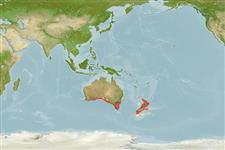Environment: milieu / Klimaatzone / Diepte / distribution range
Ecologie
marien; brak water benthopelagisch; diepte 22 - 400 m (Ref. 58489). Temperate; 32°S - 51°S, 115°E - 179°E
Southwest Pacific: confined to Australian and New Zealand seas.
Lengte bij maturiteit / Grootte / Gewicht / Leeftijd
Maturiteit: Lm 37.5, range 30 - 40 cm
Max length : 76.0 cm TL mannelijk / geslacht onbekend; (Ref. 9002); common length : 50.0 cm TL mannelijk / geslacht onbekend; (Ref. 9258); max. gepubliceerd gewicht: 4.0 kg (Ref. 9988); max. gerapporteerde leeftijd: 15 Jaren (Ref. 9072)
Adults inhabit continental shelf and slope waters (Ref. 6390). Reported from depths between 22 m (Ref. 58489) and 400m (Ref. 30458). They are schooling species, usually aggregating close to the sea bed (Ref. 26498) although there is some evidence that they move into the middle water column at night (Ref. 30459). Juveniles recorded offshore to a depth of 100 m and sometimes entering estuaries, often in association with jellyfish (Ref. 9563) and schooling close to the surface. Feed mainly on salps but also takes euphausiids, krill, crabs and small squid (Ref. 9072). Marketed fresh and frozen; eaten steamed, fried, broiled, boiled, microwaved and baked (Ref. 9988).
Determinate annual fecundity. Females spawn three batches of eggs in a season (Ref. 86821).
Kuiter, R.H., 1993. Coastal fishes of south-eastern Australia. University of Hawaii Press. Honolulu, Hawaii. 437 p. (Ref. 9002)
Status op de Rode Lijst van het IUCN (Ref. 130435: Version 2025-1)
Gevaar voor de mens
Harmless
Gebruik door de mens
Visserij: commercieel; sportvis: ja
Tools
Speciale rapporten
Download XML
Internetbronnen
Estimates based on models
Preferred temperature (Ref.
123201): 11.8 - 16.6, mean 14.4 °C (based on 98 cells).
Fylogenetische diversiteitsindex (Ref.
82804): PD
50 = 0.5156 [Uniqueness, from 0.5 = low to 2.0 = high].
Bayesian length-weight: a=0.01122 (0.00514 - 0.02450), b=3.04 (2.87 - 3.21), in cm total length, based on all LWR estimates for this body shape (Ref.
93245).
Trofisch niveau (Ref.
69278): 3.7 ±0.43 se; based on food items.
Weerstandsvermogen (Ref.
120179): Gemiddeld, minimale populatieverdubbelingstijd 1,4-4,4 jaar (K=0.19; tm=3-4; tmax=15).
Prior r = 0.65, 95% CL = 0.43 - 0.97, Based on 2 data-limited stock assessments.
Fishing Vulnerability (Ref.
59153): Moderate to high vulnerability (50 of 100).
🛈
Climate Vulnerability (Ref.
125649): Very high vulnerability (77 of 100).
🛈
Nutrients (Ref.
124155): Calcium = 17.4 [12.1, 31.0] mg/100g; Iron = 0.272 [0.175, 0.434] mg/100g; Protein = 17.5 [15.7, 19.4] %; Omega3 = 0.669 [0.393, 1.167] g/100g; Selenium = 19.4 [9.7, 34.5] μg/100g; VitaminA = 22.4 [9.6, 57.7] μg/100g; Zinc = 0.533 [0.408, 0.702] mg/100g (wet weight);
